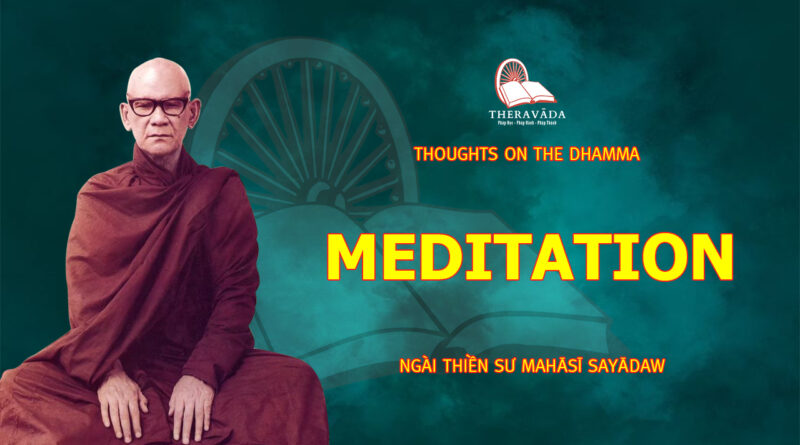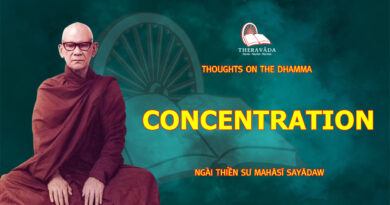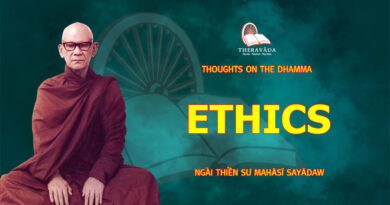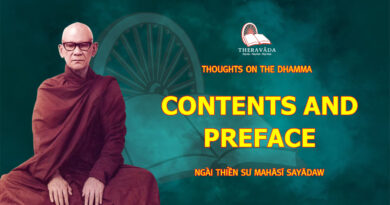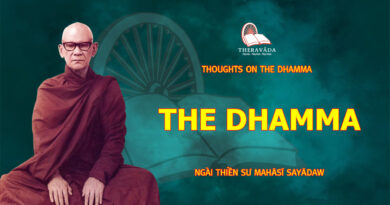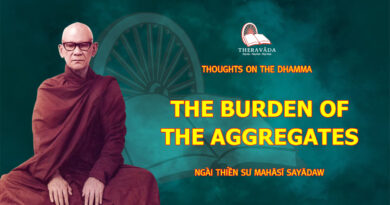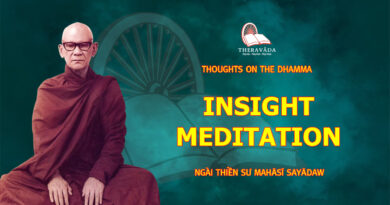Nội Dung Chính
6. Meditation
Instructions to the Meditator
To develop mindfulness and gain insight-knowledge, the following points must be borne in mind:
Recognize correctly all physical behavior as it arises.
Recognize correctly all mental behavior as it arises.
Recognize every feeling, pleasant, unpleasant, or indifferent, as it arises.
Know, with an analytical mind, every mental object as it arises.
— Discourse on To Nibbana via the Noble Eightfold Path —
Knowledge Deepens Through Practice
If the Path is practiced to gain direct personal experience, it is usual that knowledge deepens as time goes on.
— Discourse on The Wheel of Dhamma —
Initial Doubt
Some people who have never meditated may have some doubt, and no wonder! For only seeing is believing, and their skepticism is due to their lack of experience. I myself was a skeptic at one time. I did not then like the Satipatthana method as it makes no mention of nama, rupa, anicca, anatta and so forth. But the Sayadaw who taught the method was a learned monk, and so I decided to give it a trial. At first I made little progress because I still had a lingering doubt about the method which, in my view, had nothing to do with ultimate reality.
It was only later on when I had followed the method seriously that its significance dawned on me. I realized then that it is the best method of meditation since it calls for attentiveness to everything that is to be known, leaving no room for absent-mindedness. So the Buddha describes the Satipatthana method as the only way: Ekayano-maggo.
— Discourse on the Ariyavasa Sutta —
A Very Effective Remedy
If you suffer from ill health or disease, and if you have no other remedy to alleviate the pain and suffering, the meditational practice upon the suffering of illness can give at least some relief if it cannot give you a complete cure. If the pain and suffering remain in your body, the meditational practice can render relief to your mind. But if you are angry or irritated by the physical suffering, your mind will suffer, too. The Buddha compared this dual suffering to being pierced by two thorns at the same time.
Let us say a man has a thorn in his flesh, and he tries to extract the thorn by piercing another thorn into his flesh. The second thorn breaks into the flesh without being able to extract the first thorn. Then the man suffers the pain from two thorns at the same time. So also, the person who cannot make a note of the physical pain in a meditational manner suffers both physical and mental pain. But if he can ponder well upon the physical pain, he will suffer only that pain, and will not suffer mental pain.
This kind of suffering — only physical pain — is like that suffered by the Buddha and arahants, for they, too, suffer physical pain. They suffer from ill-effects of heat and cold, insect bites, and other kinds of discomfort. Though they suffer from the physical dukkha, their minds remain stable, so they do not suffer mental pain. The meditational method is a very effective remedy for physical pain and suffering.
— Discourse on Lokadhamma —
Depression
We should keep in mind the law of kamma — the Buddha’s teaching that everything happens according to one’s actions — and bear our misfortunes calmly. The best remedy in a crisis is the practice of samatha or Vipassana. If sorrow, grief, or depression afflicts us, during meditation hours such unwholesome states of consciousness must be noted and removed. The Buddha describes the Satipatthana method as the only way to get over grief and end all suffering. So long as we keep ourselves mindful according to Satipatthana teaching, we never feel depressed, and if depression arises, it passes away when we focus our attention on it.
— Discourse on the Sakkapañha Sutta —
Despair
Some meditators are disheartened because of their weak concentration at the outset, but as a result, some redouble their effort and attain unusual insights. So the meditator may benefit by his despair at this stage. According to the commentaries, we should welcome the despair that results from non-fulfillment of desire in connection with renunciation, meditation, reflection, and jhana.
Sorrow is wholesome when it arises from frustration over any effort to promote one’s spiritual life, such as the effort to join the holy order, the effort to attain insight, and so forth. We should welcome such sorrow for it may spur effort and lead to progress on the Path. It is not, however, to be sought deliberately. The best thing is to have wholesome joy in the search for enlightenment.
— Discourse on the Sakkapañha Sutta —
Strenuous Effort
Strenuous, relentless efforts in meditation practices for achievement of concentration and insight should not be misconceived as a form of self-torture. Leaving aside meditation practices, even the keeping of the moral precepts which may entail some physical discomfort and abstention, is not to be regarded as a practice of self-mortification.
In the practice of concentration and insight meditation, patience, and self-control (khanti-samvara) khanti-sa.mvara play an important role; they are important factors for the successful practice of both. Therefore unpleasant physical discomfort should be borne with patience. The self-control practiced thus is not self-mortification, inasmuch as its goal is not the afflicting and enduring of pain but one’s progress in virtue, concentration, and wisdom (sila, samadhi, paññ) as enjoined by the Buddha.
— Discourse on The Wheel of Dhamma —
How to Avoid the Two Extremes
Of the five sense objects — namely, sight, sound, smell, taste, and touch — those objects which would not violate observance of the precepts or which would be helpful to the practice of Dhamma may be made use of. Eating food which should be normally eaten, wearing clothes which should be normally worn, contributes to easeful practice of Dhamma, thus avoiding the extreme austerity of self-mortification.
Necessary material goods such as food, clothing, medicine, and shelter should be used, accompanied either by reflective contemplation or the practice of concentration or insight-meditation. Every time contact is made with the five sense objects, they should be noted as objects of insight-meditation. By adopting a reflective mood or by noting these sense objects as objects of insight-meditation, partaking of necessary food, clothing, etc., does not develop into enjoying them with delight or pleasure, thereby avoiding the other extreme of indulgence in sensuous pleasures. The Blessed one declared, therefore, that “Having avoided these two extremes (parts, practices), I have come to understand the Middle Path.”
— Discourse on The Wheel of Dhamma —
Purity of Mind
You have purity of mind when you are mindful. It is a mistake to think that one can attain it only when one enters meditative absorption (jhana). Purity of mind based on jhana is due to the continuous stream of jhanic consciousness. Purity of mind through Vipassana is the purity that emerges at the moment of attaining insight. Both kinds of consciousness are alike in respect to purity of mind and freedom from hindrances.
— Discourse on the Ariyavasa Sutta —
____________________

